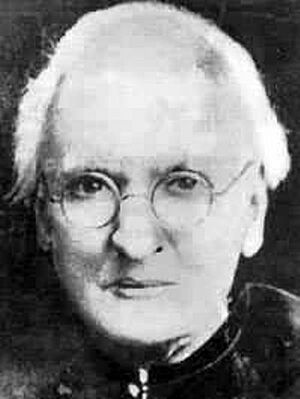Amadeus William Grabau facts for kids
Quick facts for kids
Amadeus William Grabau
|
|
|---|---|
 |
|
| Born | January 9, 1870 Cedarburg, Wisconsin, United States
|
| Died | March 20, 1946 (aged 76) |
| Resting place | compound of the geological department of the National University of Peking |
| Monuments | Dorsum Grabau, a wrinkle ridge on the Moon named for him |
| Nationality | American |
| Other names | the father of Chinese geology |
| Education | |
| Occupation | Paleontologist |
| Employer |
|
| Known for |
|
|
Notable work
|
|
| Spouse(s) | Mary Antin (m. Oct. 5, 1901) |
| Children | one daughter |
| Relatives |
|
| Awards | Mary Clark Thompson Medal (1936) Hayden Memorial Geological Award (1941) |
Amadeus William Grabau (January 9, 1870 – March 20, 1946) was an American scientist. He was a geologist, a teacher, and a writer. He studied stratigraphy (how layers of rock are formed) and paleontology (the study of fossils). Grabau worked in both the United States and China.
Contents
A Life of Scientific Discovery
Amadeus Grabau's family came from Germany. His grandfather, Johannes Andreas August Grabau, led a group of people who moved to America. Amadeus started school in his hometown of Cedarburg, Wisconsin. He then went to public high school there.
Early Education and Interests
When his father became a leader at a seminary in 1885, Amadeus finished high school in Buffalo, New York. He worked as a bookbinder and took classes at night. He became very interested in the fossils he found nearby. A geologist named William Otis Crosby was so impressed by Amadeus that he hired him. Crosby also helped him get into Boston Latin School, MIT, and Harvard.
Teaching and Moving to China
Grabau taught at MIT and Rensselaer Polytechnic Institute early in his career. In 1901, he became a professor at Columbia University in New York City. He married Mary Antin, who later became a famous author.
During World War I, times became difficult. In 1919, he left Columbia University and moved to China. He became a professor at Peking University in October 1920. He also joined the Chinese Geological Survey.
Father of Chinese Geology
Amadeus Grabau spent much of his life studying the geology of China. He is now known as the "father of Chinese geology" because of his important work.
In 1936, he received the Mary Clark Thompson Medal. This award is given for important contributions to geology and paleontology. Grabau stayed in Peking during World War II. Around 1941, he was held by the Japanese Imperial Army. His health became very poor, and he passed away after his release.
Grabau's Big Ideas and Books
Grabau was a very busy writer. He published at least 10 books in the first half of the 1900s. He developed several important ideas during his life.
Theories About Earth
One of his ideas was about the "rhythms" of the Earth's crust. This theory looked at how the Earth's outer layer grows and changes over time. He also had a theory about how mountains are built.
Lunar Recognition
In 1976, a wrinkle ridge on the Moon was named Dorsum Grabau in his honor. This shows how important his work was.
List of Books
Here are some of the books Amadeus Grabau wrote:
- North American Index Fossils (1909, 1910)
- Grabau A. W. & Shimer H. W. 1909. Invertebrates. Volume I.
- Grabau A. W. & Shimer H. W. 1910. Invertebrates. Volume II.
- Principles of Stratigraphy (1913)
- Textbook of Geology (1920–21) Two volumes: Part I; Part II.
- Silurian Fossils of Yunnan (1920)
- Ordovician Fossils of North China (1922)
- Paleozoic Corals of China (1921)
- Stratigraphy of China (1924–25)
- Migration of Geosynclines (1924)
- Early Permian Fossils of China (1934)
- Rhythm of the Ages (1940)

